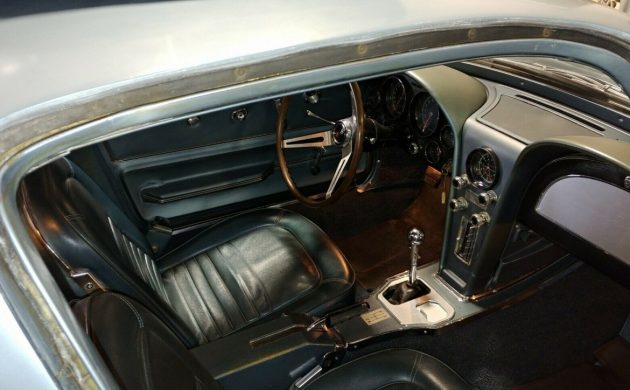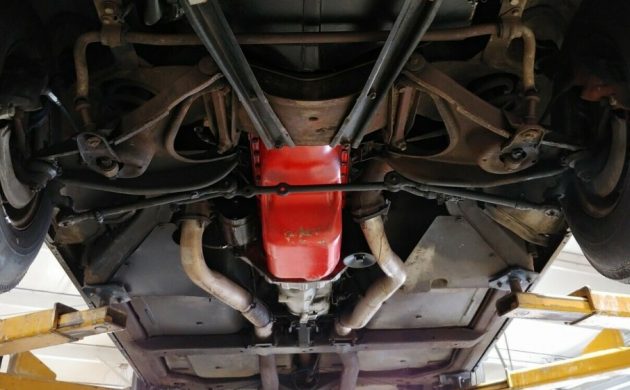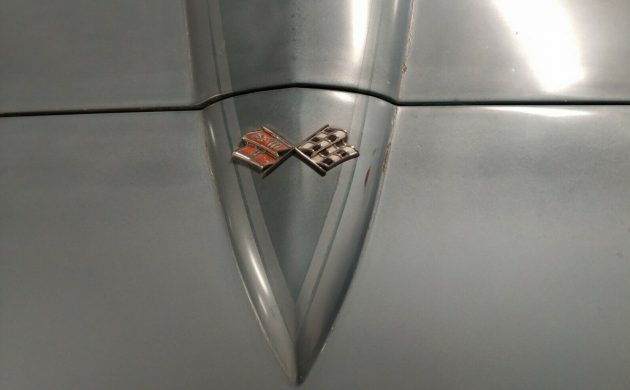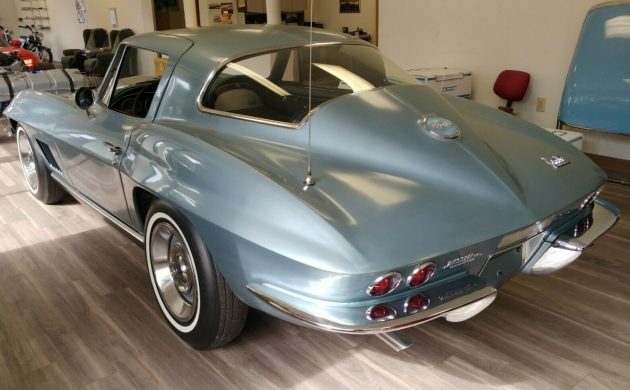When one thinks of C2 Corvettes, images of ’63 split-windows dance through our heads. Yes, it is an iconic design and the backstory of the “debate” between Chief Designer Bill Mitchell (loved it) and Corvette General Manager, Zora Arkus-Duntov (hated it) is the stuff of Corvette legend. Of the five years that the C2 existed (’63-’67) I think I like the ’67, like this one located in North Charleston, South Carolina, and available here on eBay, the best. This all-original survivor currently has a current bid of $68,199, reserve not met yet. Thanks to Patrick S for the tip!
Why the ’67? I think it is the cleanest iteration of the C2. Now I know it is subjective, we all like certain versions of cars for certain reasons. There may be some “undeniably beautiful” and “unapologetically ugly” cars out there but there is a wide swath in the middle of who likes what and why. So, let’s pick through this beautiful ’67 survivor in detail and see what really makes it tick.
I like Chevrolet big-block engines and I know a thing or two about them because I have owned and wrenched on several. This ’67 is equipped with what is known as RPO-L36. It is a 390 HP, 427 CI, Mark-IV engine. In spite of its prodigious power, it is still considered by Chevrolet to be a low-performance or “passenger” series engine. What does that really mean? In essence, don’t push it beyond 5,500 RPM, this isn’t a rev-happy small-block we’re talking about or one of the true high-performance big block motors. These are quality designed and built engines but high RPM stunts are not their forte. This is the third year for the Mark-IV motor’s appearance in the C2 and it is the first year for the “side-oiler” design (not an official designation, just a descriptive one) which lubricates the crankshaft mains and rods before hitting the cam, lifters and valve train. It was done to force more consistent oil pressure where it was needed and to help mitigate the spun-bearing issue that was occurring haphazardly with the ‘65 & ‘66 Mark-IV’s. In my experience, these ’67 and later engines are preferred. The only downside is that the hydraulic lifters in these start to sound like mechanical ones when you get some mileage on the motor, 109,347 miles in this case. The lifters are adjustable however and that may have to be done periodically to limit the “clack”. So, how does it run? In general, these are beasts but this owner gives us no information regarding what is probably the most important facet of this ‘Vette – a bit of a neglected item on so auspicious a car. Some Corvette enthusiasts prefer the 327 CI small block engine because of the weight difference and the tendency of the big-block equipped car to understeer but I’ll leave that debate up to our informed Corvette reader base. Surprisingly, there is no reference to the transmission either but the interior image clearly shows it to be a four-speed manual. Good to know because the automatic option was a Powerglide two-speed, I would consider that a let-down in a car like this.
Speaking of the interior, standard ’67 Corvette all the way. The black bucket seats look perfect and the exterior color, Elkhart Blue, painted dash center section is vintage Corvette. The dash gauges look really clean considering their age, they frequently get dusty with the passage of time. Carpet looks practically new!
Down below, the underside of this Corvette is clean as a whistle. There are usually traces of oil or grease, not leaks necessarily, just the aura of mechanical goings-on’s but that’s not the case with this ‘Vette. It doesn’t look restored, just in “as expected” survivor condition.
Elkhart Blue is one of my favorite Corvette colors and this C2 wears it beautifully. The 52-year-old lacquer finish appears to be mostly undisturbed with a bit of fading but no signs of crazing. And it complements the straight body panels and consistent shunt lines. Aging fiberglass sometimes reveals the bonding strips under the finish but none are detectable in accompanying images.
So, 1967 is the last of the C2 Corvettes and the last one to use the Powerglide automatic transmission. It is also the first Corvette to use Chevrolet’s famous “Rally” wheel, a standard feature on Corvettes through the ’82 model year though the center cap in ’67 was a one year only item. The C3 that replaced the C2 is very similar in terms of the power train, suspension and underside dimensions/architecture but the body was almost as radical a departure from the C2 as the C2 was from the C1, almost. This Corvette really appears to be the real deal, a very original and genuine car. Nevertheless, I can’t imagine this kind of financial outlay via an on-line auction without seeing the car for real, especially when the accompanying description is so undescriptive. And the seller does recommend a physical inspection by prospective bidders or their representatives. I would like to know, have any you ever bought a car, especially a high dollar example, via on-line auction and was it everything that you were thinking it would be?








Nice looking C-2 survivor! My favorite year. I wish it had factory side pipes. Maybe it’s just me, but I prefer the L79 combination with a 4 speed. The 327 has plenty of power and isn’t front end heavy like the 427.
I’m sorry, but there is nothing “front end heavy” about any 65-74 big block Corvette. People have been claiming this for 50 years, but it’s simply not the case.
The 63-82 Corvette’s engine is set back in the frame, behind the front crossmember, allowing it to be mounted low in the chassis. The engine’s mounting location gives the small block a 49/51 weight balance, and the big block a perfect 50/50 balance.
I love small blocks, but the 66-69 427/390 may be one of the best all around Chevrolet engines. The 390 offers tons of torque, effortless cruising, and is relatively maintenance free with it’s milder cam, and hydraulic lifters.
Big block Chevelles, Camaro’s and Nova’s, are front heavy, because their engines are mounted over the front crossmember, but not Corvettes.
90 pound difference between the SBC and BBC. Big deal. A full tank of gas in a 67 Corvette weighs 125 pounds. How come nobody ever worries about all that weight in the back?
I had a ’67 … 427 .. 435 hp .. convertible .. side pipes .. 3 tail lights .. owned by the Prince of Qatar for 4 years when he went to Whittier College .. paid $3600 .. wish I still had it.
Stunning car, and so radical for the time. I can’t even imagine how much of a bada** you must have been to rock one of these around in 1967.
Lovely clean looking car.
I know I am slightly biased because I owned a coupe, but I always preferred the coupe over the convertible. The year of the car doesn’t matter as much to me, although I know they had ironed out most of the bugs by 67.
I also would prefer the 350hp small block with a 4 spd, over the 390 hp big block. This is more for the balance of the car on the highway, but there is nothing quite like winding up a 327 on those tight winding roads.
I loved the look of the side pipes, but they get old fast on a long trip.
I also like the rally wheels, but my favourite wheels of all time, are the knock offs. I had them on my 64, and made it look like a different car.
Bob
There is a 90 pound difference between a 327 and 427. Would the average driver on the average road really notice the difference?
I don’t know about the “average” driver, but any experienced driver would feel the difference. My thinking is, that the average driver wasn’t going to spend the extra money to buy even the 390 hp big block. I am not trying to bad mouth the big block, I love them and have several, including a 435 hp Corvette 427. They are wonderful engines.
There is a way to solve the problem, aluminum heads, but even better, the aluminum block.
Just thinking about that prospect, has me drooling on my keyboard.
Bob
Don’t think Chevy made aluminum oval port heads. I don’t think the 90lb difference would be noticed, that is UNTIL you mashed down on the right hand pedal. Nothing quite like 390hp for roll on power.It will knock the air out of you.Like being kicked in the back.
Had a relative that was a Chevy/Buick dealer at that time, if he had something special and you talked nice on occasion he’d take out one of the special cars and you could get a ride. SS396’s, GS400’s, Camaros and Vettes were Dave’s area while his Dad did the ‘Folks’ cars. Between a ride in a BBC Vette, the SS396’s I went along with and others over the years, I know there are those that say there’s no penalty having a BBC but I can’t agree. Maybe if doing straight line acceleration that’s true but if you took them out on those windy county blacktop roads, they seemed to push into the corners. I can say I’ve been in one car that did not exhibit this tendency but it’s suspension was extensively modified.
Regardless, even with a powerglide it’s a great looking car.
I think they all “pushed” into the corners. Remember cars of that era had engines that were way ahead of the tires, suspension and brakes they were equipped with. I seem to remember a Car and Driver road test that had a Chrysler Minivan outhandle a 1967 Corvette on a slalom course.
I wasn’t aware of a change to early BBC’s oil distribution within the block to minimize spun bottom end bearings. I thought it was a cam bearing upgrade in later engines that increased oil flow to the bottom end. I don’t remember spun bearings as being a widespread problem. The only time I have heard the term “side oiler” applied to hi-perf Fords. However, I could be wrong.
Comet – I learned of the change many years ago when I worked for a Chevrolet dealership, I’ll try to find the technical bulletin on the change – I came across it again in the last year or so.
You are right, “Side-Oiler” is a Ford designation, I just meant it as I referenced, as a “descriptive” term, which accomplishes the same goal.
Additionally, you are correct about the groved cam bearing on the ’65 & ’66, it has to line up with the corresponding passages in the block or there will be a problem.
Thx
Having owned a ‘65 327/350 and now owing a ’67 427/400 with factory air I can say there is no substitute for the torque of BB. Yes, maybe it does under steer little more but who drives these cars at their limits any more? There are larger stabilizer bars available for those that want to tune their suspensions and newer radial tires over come a lot of the original chassis design limitations.
With a 3.36 axle and 2.20 first gear it is possible to launch in 4th gear and go all the way to redline with just a little clutch slipping at launch. Try that with any 327.
Side pipes and a half point more compression than stock make for a sweet sound in all gears and the neighbors claim they love the sound.
I didn’t have a 67 but I had a 64 in 69 327 365 at the age of 17 and It still rocked my ass off ! if you ain’t owned one you don’t know their ain’t nothing like it
yes, the 1964-65 365-375 and the 1967-69 DZ 302 motors used that big cam and it really woke up the power in the higher ranges. Aftermarket cams took it to another level as did the later engines with roller cams. It would be so fun to drive a light C1, or C2 Corvette with even a 302 cu in small block with the right cam. About the only thing better would be a Ferrari.
I got excited about this car till I read it has a power glide!! The 67 corvette with a 427 and a 4 speed was the best corvette ever!!! In my opinion!!!
Where does it say it’s a Powerglide? A 4 speed is in this one.
I just reread the write up and I stand corrected!! It is a 4 speed!! It makes it the ultimate corvette in my opinion!! Thanks for pointing that out Tom!!!
Beautiful and it’s not resale red. At almost $70,000. I strongly suggest a physical inspection especially underneath. I like it does not have N14. I had a Corvette in mid 70s with side exhaust. Yeah it was cool for about 10 miles. Then you wanted to stop and get out. Too much noise. If you want a throaty but not obnoxious sound, get N11 off Road mufflers.